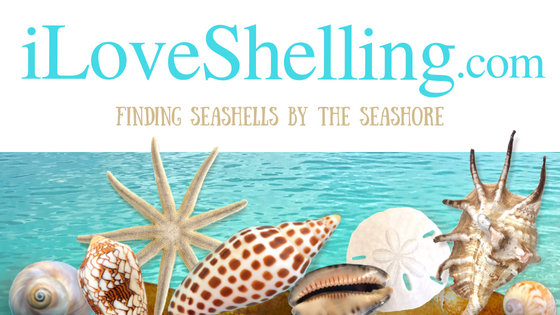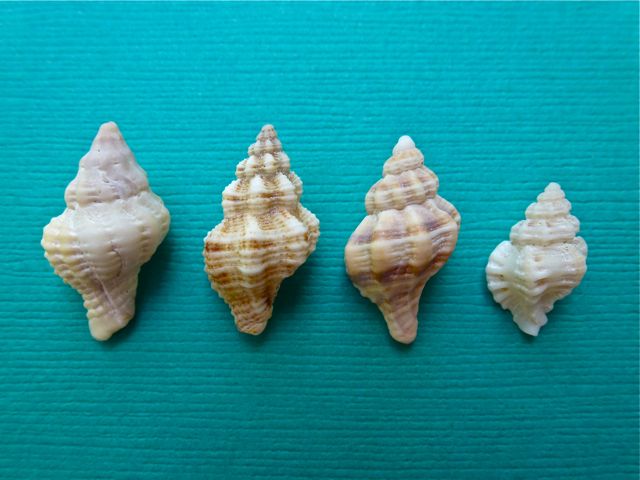Can you tell that these are four different shells? The difference between these seashells is very slight.
I found a few cutie little shells at the lighthouse that looked very similar but when I turned them over to look at the apertures to correctly identify them, I found little HERMIT CRABS in each one.
After I took the pictures, I put the shells back in the water where I found them then got inspired to head home to sift through my collection of unsorted shells. I had so many of these smaller shells lumped together so it was time to make sure I had the right identity on each one. Okay, so let’s go back and look at the shells I found in my collection at home that were so similar (but not exactly the same kind I found on the beach)…
From left to right… MAUVE-MOUTH DRILL, RIBBED CANTHARUS, GULF OYSTER DRILL and a PITTED MUREX. Here are the apertures…
I showed the MAUVE-MOUTH DRILL (and it’s eggs) in my January 24 post …
but now you can see how similar it is to the RIBBED CANTHARUS…
and the GULF OYSTER DRILL…
I’ve only showed a GULF OYSTER DRILL once before, which is strange because they are somewhat common to find on Sanibel. So here’s a closeup…
The PITTED MUREX is bit smaller (and not as common… for me any way) than the others but it’s still a bear to identify without “cheaters” on. And it is so similar too!
So now we can sift through our collections and finally identify the differences between these four shells now that we can see them side by side. Uhhhh….. I hate to tell you this…. but…. unfortunately, there a few more that look similar to these as well. For instance, …like that photo of my palm with the HERMIT CRAB shells? That top shell more to the left of the photo…. that’s a juvie APPLE MUREX! Doesn’t it look like the rest of the shells? And the shell on the far right side of my palm has a broken base so it’s harder to identify (and I didn’t get a great photo of it) but I’m sure it was a RIBBED CANTHARUS too. And y’all thought Seashell Identification was easy, didn’t you? heehee
RIBBED CANTHARUS, APPLE MUREX, MAUVE-MOUTH DRILL, broken RIBBED CANTHARUS (I’m sure).













Very cool…and I need glasses…sigh…lol
When you add in mutations and any wear and tear, it makes them even harder to tell them apart. I ended up putting them all in the same jar after many frustrating hoyrs trying to determine which ones were which.
Because of your find of the “MAUVE-MOUTH DRILL”, I went through all of my mini’s looking for one. Not a one did I find, but I found a lot of those others that were similar. Had fun looking through all of them on a cold winter day here in Michigan.
I love the little ones and have way too many to sort! This post came at the perfect time, too—my sister is there now and sent me a photo this afternoon of her holding one of these lttle lovelies in the palm of her hand!
I’ve got a bunch of itty-bitties, and today I decided that I would try to catch up on cleaning and sorting them. I’m in Northern Florida, so I’m not very likely to find many of the shells that you find around Sanibel, but it is usually without fail that I will find some hidden gem amonst the scoops of tiny shells that I bring home.
This is a bit off-topic, but do you offer any shell identification services? I’ve got a fragment of a large grey, scallop-like shell that I cannot find anywhere. I found it at Ft Clinch State Park a couple of weeks ago, amongst some large whelk and conch fragments (I think the long fishing pier and jetties are to blame for mostly fragments being found there. I will NOT be returning there for shelling purposes!).
Anyways, if you could let me know, that would be great!
Inaya, You can post a picture of the fragments on the i Love Shelling facebook page at https://www.facebook.com/iLoveShelling. If you have several photos of different angles, choose “make a photo album” button on your fb page then share it with us at iLS. I’d love to see them!
:D Good post!
Very nice presentation of these small, similar shells. Thanks.
No, I don’t think identifying seashells is easy! And you made the point. I don’t have any of those shells, but your photos make identifying more fun. Thanks for the help.
Thanks for the i.d. tips. Would you consider a little picture-show i.d. blog for juvies (as you call them)? I know the conchs have juvenile forms, but so do cowries and others, I’m sure. Maybe the murexes? Just curious. Thanks for the lovely website. I go here every day and drool.
On the first photo where the names are given for each of the four, I think the ribbed cantharus & gulf oyster drill names should be reversed,since their names are shown further along & don’t coincide? It is confusing with these smaller cuties.
Barb, you must have a sharp eye. You are correct. The ribbed cantharus is second from the left and the Gulf oyster drill is third from the left. Pam had the ID’s correct on all the other pictures. I think that this was just a typo. Very easy to do with so many shells and pictures.
Oh boy, yes, it was reversed but now I corrected it. Thank you Barb!!! I’m surprised I didn’t have more typos since this little project post turned into a much BIGGER project than I had expected- yikes! Thank you again for pointing this out- I hate to give bad info! But then again, I’m so happy that you looked at it that closely to see the difference!!!
Doesn’t take much to confuse me, Pam. I enjoy all your info/photos & thought I knew a lot about shelling until I discovered your site. Will look for you/Ken on the beaches when we should be on the island between 3/13-20.
Excellent! Really interesting Pam. It’s so helpful to see more examples of each species because the books often just show you one shell and it’s hard to get a feel for the differences from only one example of something. And when you have a group of one kind you can see how they look when they are a bit worn or a bit bleached out, as well as how they look when the shell is nice and fresh.
I find the pitted murex quite distinctive, with real fancy-looking sculpture on it, but that’s probably because I always have my “cheaters” (magnifying glasses) on when I am looking for or at the small stuff! (These days I can’t function without magnifiers.) Plus I know the pitted murex from the Leeward Islands, where they don’t have the ribbed cantharus and the two drills. They have the juvenile apple murexes there, but they are always a reddish brown whereas the pitted murex is always pure white or off-white.
Thanks, Professor! I’m going to print this out and keep it with my shell books, which don’t do as well as you for identification. :)
Pam:
A year ago last January my husband went on a business trip to Puerto Rico. He asked what he could bring back as a gift. I said just bring back a bunch of shells from the beach. He did. That evening before he was to leave for Florida, he went on the beach and gathered a bunch of sea shells….most were very small Zebra nerite shells. He put them in a plastic bag in his luggage and brought them home to me. I spread them out on the kitchen table and to my surprise (you know where this is going) 4 of the shells were moving. To make a long story short – they have grown to triple their size (luckily I collect shells and had an assortment of homes for them to move into as they molted and grew). I am absolutely delighted with them, but yes, I feel badly they were kidnapped from their beautiful home in PR. I thank the wonderful hermit crab websites for all their support and information. Now I just need to get a bigger tank! Thea